Contaminated countries need a wide range of support to meet the challenges posed by explosive ordnance (EO), from capacity sharing across a range of topics, through to developing tailored solutions in the management of mine action operations.
Mine action operations usually support of policy and strategy implementation and focus on the removal of EO in a safe, effective, and efficient manner. This includes responding to new types of contamination, such as the recent spread of improvised explosive devices (IED) being used on a large scale, or the introduction of new techniques, such as the use of surveys to reduce the effort in releasing land.
The Operations Management (OM) Programme supports countries through two, long term initiatives. The first is a learning initiative, based on the development and implementation of learning opportunities, which are delivered either nationally, regionally, or globally.
The second, the Mine Action Management Systems project, provides platforms for management topics to be discussed and facilitates the exchange of solutions among the mine action community.
The learning initiative provides the mine action sector with a range of opportunities to professionalise the sector and, as part of the initiatives to enhance capacities within the sector, strives to work towards improved management of mine action programmes, resulting in operations being implemented more safely, effectively, and efficiently. The development of these courses is driven by the needs observed in the field and is continually adapting and evolving. The topics range in scope and vision from the training of management professionals within the sector, through to the initiation of new trainers, who themselves go on to train others in the areas of quality management, risk management and operational analysis. The courses are designed to be accessible to a wide range of mine action professionals, with the development of blended instructor-led and self-paced learning becoming a significant step forward.
The Mine Action Management Systems project links various aspects of the mine action sector into coherent national plans. This project works towards framing national responses in up-to-date processes, which are enabled by information management. These range from supporting countries in addressing the complexities of liability in the mine action context, exploring and implementing IED responses, and plans to move into a residual phase of their mine action programmes. This project is rooted in understanding the needs of EO affected countries and driven by assessments of the needs.
Survey
Surveying land is an evidence-based approach to more accurately differentiate between areas that require clearance and areas that do not.
Detection and clearance
Clearance of landmines and Explosive Remnants of War (ERW) is a challenging, time-consuming and expensive activity utilizing manual deminers and the support of Animal Detection Systems (ADS), mechanical systems and remote sensing equipment.
Operational Efficiency in Mine Action
This study aims to provide a framework for mine action stakeholders to review the efficiency of their own land release operations.
Operations Management Publications
Difficult Terrain In Mine Action
Armed conflicts continue to cause an increase in the number of casualties from explosive ordnance. Even after hostilities have ended, populations living in mine-affected areas often live with the risk posed by mines and other...
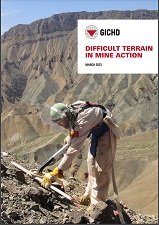
- Available in English
The Sustainable Development Outcomes of Mine Action in Jordan
This study comprehensively maps the sustainable development outcomes of mine action activities in Jordan, using the SDGs as an analytical framework. It presents concrete examples which illustrate the impact of mine action...

- Available in Arabic, English
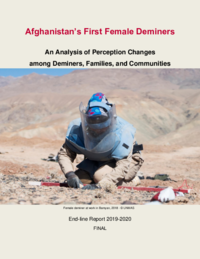
- Available in English
Geneva International Centre for Humanitarian Demining | Twenty Years of Supporting Mine Action
This book was published on the anniversary of the Geneva International Centre for Humanitarian Demining's 20th anniversary. In 1997, at the adoption of the Anti-Personnel Mine Ban Convention (APMBC), Switzerland announced its...
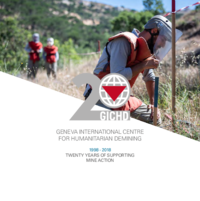
- Available in English
Information Management and Technology Development for Technical Survey in Mine Action
There is an emergent consensus that an excessive use of clearance resources in areas that may not contain landmines and/or explosive remnants of war (ERW) represents an error in miscalculation rather than justifiable prudence....
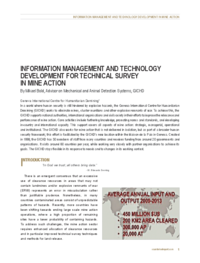
- Available in English
Doing no harm? Mine action and land issues in Cambodia
This report includes recommendations that seek to build upon good practice and strengthen systems and processes to ensure mine action efforts not only do no harm, but also bring the maximum possible benefits to beneficiary...

- Available in English
Land Release Liability
Who should be responsible for any adverse events after clearance? The process of transferring liability from an operator to the state seems biased due to an inherent conflict of interest.
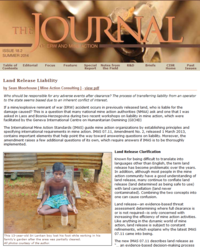
- Available in English
Amendments to the IMAS Land Release
The International Mine Action Standards (IMAS) review board formally endorsed amendments to the Land Release IMAS in April 2013 that clarify and standardize the language and practices in the series.
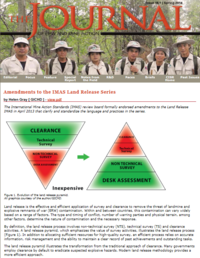
- Available in English
GICHD Geomine Demonstration Test 15 January 2014
In 2013, the Geneva International Centre for Humanitarian Demining (GICHD) participated as the lead observer in the Geomine demonstration test in Wittstock, Germany.
The technology demonstrated focuses on reducing suspect...

- Available in English
Mine Action and Land Rights in South Sudan | Key findings and recommendations
In March 2013, GICHD and the Norwegian Refugee Council (NRC) undertook a joint mission to South Sudan on land rights and mine action in order to provide mine action organisations with analysis on land related conflict and...
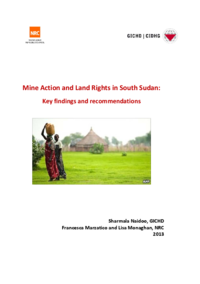
- Available in English






